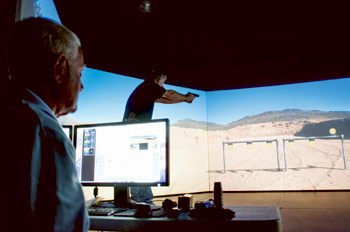Kalispell Police Chief Roger Nasset drew his weapon on the man in the kitchen, who was pointing his own handgun at the head of a woman sitting in a chair. The cries of a baby filled the room as Nasset tried to talk the man down, to lower his weapon, to step outside so they could talk about it.
The man was nearly hysterical, yelling at Nasset that the woman hadn’t let him see his kid in a long time, and she deserved this. Nasset was consistent in his demands, eventually diffusing the situation as the man dropped his weapon and knelt on the ground, empty hands in the air.
The next go round with the hostage taker ended in bloodshed, but that had less to do with Nasset and more to do with the operator at the computer, who escalated the situation despite Nasset’s desire to get out of the kitchen without firing a shot.
That’s how it is sometimes in the real world, Nasset explained to the members of the media who had gathered at Northwest Shooter near Columbia Falls to watch the demonstration of the new, state-of-the-art, use of force simulator, VirTra.
Sometimes a situation can be diffused, but other times, people will escalate to violence regardless. Law enforcement has to know how to react to both, Nasset said, and equipment like this helps teach these scenarios in a realistic-but-safe environment.
The demonstration on June 13 is one of the first peeks at what should be a popular and important training ground, for both law enforcement and the public.
“I truly believe it is the best simulator in the world that is available to law enforcement,” Nasset said.
VirTra is a $215,000 system that has been installed at Northwest Shooter. It was paid for through a $750,000 grant from the Department of Justice, sought after local law enforcement realized in 2007 that building a new outdoor shooting range was not financially feasible due to land prices and proximity to residential areas.
The rest of the money went to building the new facility that houses the program.
The system itself consists of five, large projector screens surrounding a platform, giving the person on the platform 300 degrees of area to work with. Law enforcement personnel use the same equipment they would use in the field: rifles, handguns, shotguns, pepper spray and a flashlight.
All the equipment has been fitted with lasers to react with the simulator, but still responds as it would in real life; the guns recoil and need to be reloaded once the magazines run out.
There is also the added pressure of potential pain: if the person using the simulator doesn’t recognize a threat and gets hit or shot, the “threat fire” box attached to their belt delivers a significant shock, which forces the person to get used to working through pain.
The software also records the scenario and the officer can get a playback to show them where they could have made different choices.
Law enforcement can access nearly 100 scenarios, ranging from traffic stops to school shootings. And with the ability for the operator to branch off the scenarios – either escalating or diffusing them – law enforcement personnel have nearly 500 situations to work with.
For the public, the scenarios would likely deal with those a concealed-carry permit holder might face. For example, one scenario involves waiting in line at an ATM and witnessing a mugging.
The person is then faced with a choice, to either stand back and become a reliable witness or intervene.
 |
|
Bob Hughes, co-owner of Northwest Shooter, left, operates the VirTra Simulator as Doug Davis demonstrates a target practice simulation in Columbia Falls. – Lido Vizzutti | Flathead Beacon |
VirTra is more about practicing judgment skills than hitting a target, Nasset said.
“On a live-fire range, you don’t get to practice your verbal skills,” he said.
Public and law enforcement participants can also use the simulator for skill drills, which bring up about 20 different scenarios that record accuracy, time and speed.
While the target shooting seemed fun, the real-world scenarios seemed anything but. The stress level of those involved was palpable, since the goal is to de-escalate and leave without firing a shot.
That’s what separates this machine from a video game, several law enforcement members present at the demonstration said. It’s not meant to allow users to take lives lightly, and shows true consequences, in the form of blood spatter, screams and profanity. Surround sound also presents opportunities for the operator to distract the user, bringing in dog barks or dropping tin cans in one corner of the room.
According to Bob Hughes of Northwest Shooter, each law enforcement division has their own trained system operator, and personnel would use it with this operator as well as a training officer or coach.
Law enforcement has 24/7 access to the machine through a security door on the side of the building. The public will be able to rent time on the machine for $45 a session, Hughes said.
The VirTra system is one of two west of the Mississippi that will be available for public use, and it is a collaboration among many law enforcement units, including Montana Highway Patrol, the Kalispell, Whitefish and Columbia Falls police departments, Montana Fish, Wildlife and Parks, U.S. Customs and Border Patrol, the National Park Service, and the Flathead County Sheriff’s Office.
All of the agencies donated the weapons used with the simulator, totaling about $30,000 in equipment. SI Defense also donated two AR rifles, Nasset said.
For more information on the VirTra use of force simulator, visit www.northwestshooter.com.